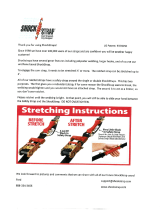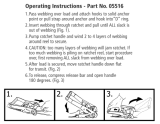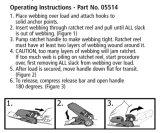Page is loading ...

Product Name: Web HLL
Instruction Manual
Part #: 04662
Do not throw away these instructions!
Read and understand these instructions before using equipment!
Introduction 1
Applicable Safety Standards
1
Worker Classifications
1
Safety Information
6
Product Specific Applications
2
Limitations
2 - 3
Components and Specifications
3
Maintenance, Cleaning, and Storage
5
Inspection
5
Installation and Use
4
Inspection Log
5
Labels
7

Introduction
Thank you for purchasing a Guardian Fall
Protection Web HLL. This manual must
be read and understood in its entirety, and
used as part of an employee training
program as required by OSHA or any
applicable state agency.
This and any other included instructions
must be made available to the user of the
equipment. The user must understand how
to safely and effectively use the Web HLL,
and all fall safety equipment used in
combination with the Web HLL.
User Information
Date of First Use:
Serial #:
Trainer:
User:
Applicable Safety Standards
When used according to instruction specifications, this product meets or exceeds all applicable OSHA 1926
Subpart M and OSHA 1910 standards for fall protection. Applicable standards and regulations depend on the
type of work being done, and also might include state-specific regulations. Consult regulatory agencies for
more information on personal fall arrest systems and associated components.
Worker Classifications
!
CAUTION
Understand the following definitions of those who
work near or who may be exposed to fall hazards.
Qualified Person: A person with an accredited degree or certification, and with extensive experience or
sufficient professional standing, who is considered proficient in planning and reviewing the conformity of fall
protection and rescue systems.
Competent Person: A highly trained and experienced person who is ASSIGNED BY THE EMPLOYER to be
responsible for all elements of a fall safety program, including, but not limited to, its regulation, management,
and application. A person who is proficient in identifying existing and predictable fall hazards, and who has
the authority to stop work in order to eliminate hazards.
Authorized Person: A person who is assigned by their employer to work around or be subject to potential or
existing fall hazards.
It is the responsibility of a Qualified or Competent person to supervise the job site and ensure all
applicable safety regulations are complied with.
Guardian Fall Protection 6305 S. 231st St., Kent, WA 98032 phone: (800) 466-6385 fax: (800) 670-7892 www.guardianfall.com
1

Guardian Fall Protection 6305 S. 231st St., Kent, WA 98032 phone: (800) 466-6385 fax: (800) 670-7892 www.guardianfall.com
2
Product Specific Applications
Personal Fall Arrest: Web HLL may be used to support a MAXIMUM 2 personal fall arrest systems
(PFAS) for use in Fall Arrest applications. Structure must withstand loads applied in the directions
permitted by the system of at least 3,600 lbs. Maximum free fall is 6‘, or up to 12’ if used in
combination with equipment explicitly certified for such use. Applicable D-ring: Dorsal.
Restraint: Web HLL may be used in Restraint applications. Restraint systems prevent workers from
reaching the leading edge of a fall hazard. Always account for fully deployed length of
lanyard/SRL. Structure must withstand loads applied in the directions permitted by the system of
at least 1,000 lbs. No free fall is permitted. Restraint systems may only be used on surfaces with
slopes up to 4/12 (vertical/horizontal). Applicable D-rings: Dorsal, Chest, Side, Shoulder.
!
WARNING
Use of equipment in unintended applications may result in serious
injury or death. Maximum 1 attachment per connection point.
For all applications, worker weight capacity range (including all clothing, tools, and equipment) is:
- For one user: 130-420 lbs.
- For two users: 130-310 lbs. (each).
MAXIMUM two users per Web HLL.
Limitations
Fall Clearance: There must be sufficient clearance below the anchorage connector to arrest a fall before the
user strikes the ground or an obstruction. When calculating fall clearance, account for a MINIMUM 2’ safety
factor, deceleration distance, user height, length of lanyard/SRL, harness stretch, lifeline deflection, and all
other applicable factors.
Swing Falls: Prior to installation or use, make considerations for eliminating or minimizing all swing fall
hazards. Swing falls occur when the anchor is not directly above the location where a fall occurs. Always work
as close to in line with the anchor point as possible. Swing falls significantly increase the likelihood of serious
injury or death in the event of a fall.
Diagram shown is an example fall clearance calculation ONLY.
Work Surface
Anchor Point
2-Person Web HLL
Deceleration Distance
Lifeline Deection
Harness Stretch
Safety Margin
Free Fall Distance
Work Surface
Swing Fall
DEFLECTION
What’s the length of your horizontal lifeline span?
SPAN =
DEFLECTION =
6.5’ 11.9’
10’
7.9’
20’
9.0’
30’
9.9’
40’
11.5’
60’
10.8’
50’ 65’
Anchor Point

Guardian Fall Protection 6305 S. 231st St., Kent, WA 98032 phone: (800) 466-6385 fax: (800) 670-7892 www.guardianfall.com
3
Components and Specifications
Compatibility: When making connections with Web HLL, eliminate all possibility of roll-out. Roll-out occurs when
interference between a hook and the attachment point causes the hook gate to unintentionally open and
release. All connections must be selected and deemed compatible with Web HLL by a Competent Person. All
connector gates must be self-closing and self-locking, and withstand minimum loads of 3,600 lbs. See the
following for examples of compatible/incompatible connections:
Materials: polyester, galvanized steel, and zinc-plated steel.
Web width: 1½”.
Part # Length
Description
04662 65’
Web HLL w/(1) Tensioner, (2) 3” O-rings, (2) 6’ Cross Arm Straps, (1) Web Assembly, & (1) Carrying Bag
Connector
closed and
locked to
D-ring. OK.
Connector
to integral
lanyard.
NO.
Two or
more snap
hooks or
carabiners
connected
to each
other. NO.
Two connectors
to same
D-ring. NO.
Connector
directly to
webbing.
NO.
Incompatible
or irregular
application,
which may
increase risk
of roll-out. NO.
Web Assembly
Ratchet Assembly
O-rings (x2)
Cross Arm Straps (x2)
Carrying Bag
IMPORTANT:
Web HLL is also provided with Bungee Tether, part #: BNGEXT1C10XT-R.
Dropped object prevention is an essential component of any jobsite safety plan.
Always adhere to all provided Bungee Tether instructions.
Bungee Tether is intended to be used in combination with removable
ratchet handle to eliminate accidental drops or misplacement.

Guardian Fall Protection 6305 S. 231st St., Kent, WA 98032 phone: (800) 466-6385 fax: (800) 670-7892 www.guardianfall.com
4
Installation and Use
Prior to use, plan your system:
1. Ensure all PFAS equipment is selected and deemed compatible by a Competent Person.
2. Determine desired location for Web HLL; ensure location is free of debris, rot, decay, cracking, and
hazardous materials. Eliminate or minimize all risk of swing fall.
3. Installation, set-up, and use of Web HLL must be done under the supervision of a Qualified Person.
4. Maximum 2 workers per Web HLL.
Installation:
1. Determine intended system length (maximum 65’) and anchor point installation locations. Anchor points
must be directly across from each other, so that Web HLL will be completely level and not slope in any way
when installed.
2. Install Cross Arm Straps around compatible structural anchor points, as determined by a Competent Person.
Note: it is also permitted to connect Web HLL to anchorage connectors other than Cross Arm Straps, provided
applicable anchorage connectors are deemed compatible with Web HLL by Competent Person.
3. Attach Ratchet Assembly at one anchor point end,
and Web Assembly at other anchor point end.
4. Thread free end of Web Assembly through slotted
drum as shown. Pre-tension system by pulling webbing
through drum until taut and slack is eliminated.
Failure to take up excess slack may result in webbing
damage and prevent ratchet from locking properly.
5. Tension Web HLL to final position with ratchet.
Pull towards web to tighten, push back toward shock
absorber, and repeat. Hold rubber grip of ratchet only.
Do not grip ratchet release lever, which is only
used during removal.
6. Web HLL is properly tensioned when green
tension indicator is visible next to green arrow on
label. DO NOT USE if either red indicator aligns
with green alignment arrow on label. ALWAYS
inspect tension indicator prior to, and periodically
during, each use to ensure proper tension is
maintained.
7. Remove ratchet handle by fully pulling up
on release lever and lifting away from Ratchet
Assembly. Do not pull back on handle, as this
may accidentally release tension on Web HLL.
8. Attach complete and compatible PFAS to HLL
O-rings. Maximum 1 connection per O-ring.
9. To uninstall, first reattach ratchet handle. Then,
pull up partially on ratchet release lever until
bottom of release no longer rests in ratchet
channel. Then, pull down fully on handle until
tension is released.
Thread Web
Assembly here.
Tension
Ratchet
release
lever.
Ratchet
rubber
grip.
Ratchet release
pulled up and
away from
ratchet.
X
X

Guardian Fall Protection 6305 S. 231st St., Kent, WA 98032 phone: (800) 466-6385 fax: (800) 670-7892 www.guardianfall.com
5
Maintenance, Cleaning, and Storage
If Web HLL fails inspection in any way, immediately remove it from service, and contact Guardian to inquire
about its return or repair. Cleaning after use is important for maintaining the safety and longevity of Web HLL.
Remove all dirt, corrosives, and contaminants from Web HLL before and after each use. If Web HLL cannot be
cleaned with plain water, use mild soap and water, then rinse and wipe dry. NEVER clean Web HLL with corrosive
substances. When not in use, store equipment where it will not be affected by heat, light, excessive moisture,
chemicals, or other degrading elements.
Prior to EACH use, inspect Web HLL for deficiencies, including, but not limited to, corrosion, deformation, pits,
burrs, rough surfaces, sharp edges, cracking, rust, paint buildup, excessive heating, alteration, and missing or
illegible labels. Careful inspection should be made at location where ratchet contacts web lifeline; excessive
turns of ratchet drum may accelerate webbing wear. Bar tack stitching is present at both ends of web
assembly shock absorber, as shown below. If inspection shows bar tack stitching is broken or deployed in any
way the product has been exposed to excessive force and must not be used. IMMEDIATELY remove Web HLL
from service if defects or damage are found, if exposed to forces of fall arrest.
Inspection
Inspection Log
If equipment fails inspection
IMMEDIATELY REMOVE FROM SERVICE.
Date of First Use: __________________.
Product lifetime is indefinite as long as
it passes pre-use and Competent Person
inspections. User must inspect prior to
EACH use. Competent Person other than
user must complete formal inspection
at least every 12 months. Competent
Person to inspect and initial.
This inspection log must be specific to
one Web HLL. Separate inspection logs
must be used for each Web HLL. All
inspection records must be made visible
and available to all users at all times.
INSPECTED BY:
Date:
Initials:
Ensure that applicable work area is free of all damage, including, but not limited to, debris, rot, rust, decay,
cracking, and hazardous materials. Ensure that selected work area will support the application-specific
minimum loads set forth in this instruction manual. Work area MUST be stable.
At least every 12 months, a Competent Person other than the user must inspect Web HLL. Competent Person
inspections MUST be recorded in inspection log in instruction manual and on equipment inspection grid
label. The Competent Person must sign their initials in the box corresponding to the month and year
the inspection took place.
During inspection, consider all applications and hazards Web HLL have been subjected to.
Bar Tack Stitch Location
(under end of shrink tube)
Bar Tack Stitch - REMOVE FROM SERVICE
Bar Tack Stitch - GOOD
Deployed Shock
Absorber
Any visual evidence of deployment
is a primary indicator of excessive
load - IMMEDIATELY remove Web
HLL from service.

Guardian Fall Protection 6305 S. 231st St., Kent, WA 98032 phone: (800) 466-6385 fax: (800) 670-7892 www.guardianfall.com
6
Safety Information
Failure to understand and comply with safety regulations may result in
serious injury or death. Regulations included herein are not all-inclusive,
are for reference only, and are not intended to replace a Competent
Person’s judgment or knowledge of federal or state standards.
!
WARNING
Do not alter equipment. Do not misuse equipment.
Workplace conditions, including, but not limited to, flame, corrosive chemicals, electrical shock, sharp objects,
machinery, abrasive substances, weather conditions, and uneven surfaces, must be assessed by a Competent
Person before fall protection equipment is selected.
The analysis of the workplace must anticipate where workers will be performing their duties, the routes they
will take to reach their work, and the potential and existing fall hazards they may be exposed to. Fall
protection equipment must be chosen by a Competent Person. Selections must account for all potential
hazardous workplace conditions. All fall protection equipment should be purchased new and in an unused
condition.
Fall protection systems must be selected and installed under the supervision of a Competent Person, and used
in a compliant manner. Fall protection systems must be designed in a manner compliant with all federal, state,
and safety regulations. Forces applied to anchors must be calculated by a Competent Person.
Unless explicitly stated otherwise, the maximum allowable free fall distance for lanyards must not exceed 6’.
No free fall allowed for non-LE SRLs. Class A SRLs must arrest falls within 24”; Class B SRLs must arrest falls
within 54”.
Harnesses and connectors selected must be compliant with manufacturer’s instructions, and must be of
compatible size and configuration. Snap hooks, carabiners, and other connectors must be selected and applied
in a compatible fashion. All risk of disengagement must be eliminated. All snap hooks and carabiners must be
self-locking and self-closing, and must never be connected to each other.
A pre-planned rescue procedure in the case of a fall is required. The rescue plan must be project-specific. The
rescue plan must allow for employees to rescue themselves, or provide an alternative means for their prompt
rescue. Store rescue equipment in an easily accessible and clearly marked area.
Training of Authorized Persons to correctly erect, disassemble, inspect, maintain, store, and use equipment
must be provided by a Competent Person. Training must include the ability to recognize fall hazards, minimize
the likelihood of fall hazards, and the correct use of personal fall arrest systems.
NEVER use fall protection equipment of any kind to hang, lift, support, or hoist tools or equipment, unless
explicitly certified for such use.
Equipment subjected to forces of fall arrest must immediately be removed from use.
Age, fitness, and health conditions can seriously affect the worker should a fall occur. Consult a doctor if there
is any reason to doubt a user’s ability to withstand and safely absorb fall arrest forces or perform set-up of
equipment. Pregnant women and minors must not use this equipment.
Physical harm may still occur even if fall safety equipment functions correctly. Sustained post-fall suspension
may result in serious injury or death. Use trauma relief straps to reduce the effects of suspension trauma.

Guardian Fall Protection 6305 S. 231st St., Kent, WA 98032 phone: (800) 466-6385 fax: (800) 670-7892 www.guardianfall.com
7 85379 (Rev. B)
Labels
TENSION
UNTIL GREEN
IS VISIBLE
HERE
DOM:
Part #: 04662
WEB HLL TENSIONER
SERIAL #: LOT #:
Designed and Engineered
in the U.K.
Compliant with all applicable OSHA 1910
and OSHA 1926 Subpart M regulations.
91024-1 (Rev. A)
All PFAS equipment must be selected and deemed compatible by a
Competent Person. All installation, set-up, and use of HLL must be
done under supervision of a Qualified Person. Refer to instructions
for compatible connections and installation procedure. User must
inspect prior to EACH use. Competent Person must complete formal
inspection every 12 months. Competent Person to inspect and initial.
Always avoid all hazards, including, but not limited to, chemicals,
corrosive substances, excessive heat, electric shock, sharp and
abrasive edges and surfaces.
Prior to use, read and understand all manufacturer’s instructions
provided with equipment at time of shipment.
1 USER CAPACITY (incl. all equip.): 130-420 lbs. per User.
2 USER CAPACITY (incl. all equip.): 130-310 lbs. per User.
MAX. 2 Users per HLL.
MATERIALS: Polyester, galvanized or zinc-plated steel.
LENGTH: 65’
1-800-466-6385
www.guardianfall.com
DO NOT REMOVE LABELS
Assembled in USA
SAMPLE
SAMPLE
Part #: 04662 WEB HLL TENSIONER
1-800-466-6385 www.guardianfall.com
If equipment fails inspection, or shock pack shows
signs of deployment, IMMEDIATELY REMOVE
FROM SERVICE
Product lifetime is indefinite, as long as product
passes all inspection requirements.
INSPECTED BY:
Date:
Initials:
Date of First Use:
91024-2 (Rev. A)
/




